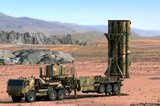QinetiQ to play pivotal role in US Army’s next-generation target acquisition system
The LRAS3, seen here in service with Georgia National Guard, is expected to be replaced by FALCONS. (Photo: Georgia National Guard)
QinetiQ US has announced its involvement in the US Army’s FALCONS optical sensor system which is planned to replace the existing Long-Range Advanced Scout Surveillance System (LRAS3).
FALCONS is designed to provide enhanced all-weather target detection and identification at ranges exceeding enemy weapons systems' effective ranges. It will enhance the US Army's battlefield sensing capabilities while supporting its modernisation objectives for 2030 and beyond.
According to QinetiQ, “the FALCONS programme represents a significant advancement in military sensor technology, incorporating artificial intelligence [AI] and potential semi-autonomous capabilities.
Related Articles
DRS Technologies receives $20.3m follow-on order for LRAS3
Raytheon integrates LRAS3 connectivity in recent exercise
“It is designed to reduce soldier workload while improving target detection and recognition.”
The effort is led by the US Army’s Programme Executive Office - Intelligence, Electronic Warfare and Sensors (PEO IEW&S).
The office sees the programme as “[leveraging] machine learning and AI to increase the speed and accuracy with which an operator detects, recognises, and identifies threats.
“FALCONS will be a truly paradigm-shifting capability that will enable the army to outpace the threat for many years to come.”
QinetiQ has history with PEO IEW&S dating back to 2016.
Earlier this year the company was awarded a five-year, US$31.5 million task order supporting the office in the the design, development and integration activities for the Integrated Sensor Architecture programme. This contract aims to help support data sharing of sensors seamlessly across battlefield networks.
Related Equipment in Defence Insight
More from Land Warfare
-
![Hanwha awarded $482 million in major step for South Korea’s missile defence programme]()
Hanwha awarded $482 million in major step for South Korea’s missile defence programme
The deal to produce and supply launchers and missiles to South Korea follows a contract placed with Hanwha Systems last month for the manufacture of multi-function radars.
-
China goes for ground-launched attack weapons as it strengthens deterrence strategy
China has been advancing its capabilities with a new generation of precision-guided artillery and loitering munitions, positioning ALIT’s WS-series as direct competitors with Western systems like the US’s M982 Excalibur.
-
![Land forces review: British Army vehicle programme stalls and company results land]()
Land forces review: British Army vehicle programme stalls and company results land
In the first monthly review of land forces stories, the Shephard team looks back to evaluate the major news events that have impacted the sector. The UK’s Land Mobility Programme was notable but another setback occurred when a market industry day was scrapped.
-
![Sweden boosts air defence capabilities with Diehl Defence, Saab and MBDA orders]()
Sweden boosts air defence capabilities with Diehl Defence, Saab and MBDA orders
The orders continue the country’s growing investment in its air defence systems across land and sea, coming months after previous investments by the government into IRIS-T SLM equipment.
-
![Russian T-90MS MBT goes for maximum survivability]()
Russian T-90MS MBT goes for maximum survivability
The in-production T-90MS comes with five levels of protection to tackle a wide range of evolving threats on the battlefield.























